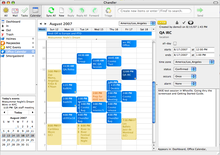
Back Chandler (aplicación informática) Spanish Chandler Finnish Chandler (informatique) French Chandler (ソフトウェア) Japanese Chandler (PIM) Swedish
 Chandler calendar | |
| Developer(s) | Open Source Applications Foundation |
|---|---|
| Final release | 1.0.3.1
/ July 30, 2009[1] |
| Written in | Python |
| Operating system | Linux, Mac OS X, Microsoft Windows |
| Type | Personal information manager |
| License | Apache License 2.0 |
| Website | www |
Chandler is a discontinued personal information management software suite described by its developers as a "Note-to-Self Organizer"[2] designed for personal and small-group task management and calendaring. It is free software, previously released under the GNU General Public License, and now released under the Apache License 2.0.[3] It is inspired by a PIM from the 1980s called Lotus Agenda, notable because of its "free-form" approach to information management. Lead developer of Agenda, Mitch Kapor, was also involved in the vision and management of Chandler.
Chandler consists of a cross-platform desktop application (Windows, Mac OS X, Linux), the Chandler Hub Sharing Service, Chandler Server, Chandler Quick Entry for iPhone,[4] and Chandler Quick Entry for Android.[5] Version 1.0 of the software was released on August 8, 2008.[6]
Chandler was developed by the Open Source Applications Foundation (OSAF). It is named after the mystery novelist Raymond Chandler.[7]
- ^ Baillie, Grant. "Chandler Desktop 1.0.3.1 released (Ubuntu Jaunty only)". The Chandler Project Blog. Archived from the original on 28 January 2015. Retrieved 24 January 2015.
- ^ Official statement by the Open Source Applications Foundation Archived 2005-02-20 at the Wayback Machine.
- ^ "Chandler is now licensed under the Apache 2.0 License". The Chandler Project Blog. OSAF. 2006-08-02. Archived from the original on 2006-10-12. Retrieved 2012-10-29.
- ^ Chandler Quick Entry for iPhone Archived 2009-08-08 at the Wayback Machine
- ^ Chandler Quick Entry for Android Archived January 21, 2010, at the Wayback Machine
- ^ Chandler Project Blog Archived August 12, 2008, at the Wayback Machine
- ^ Rosenberg, Scott. Dreaming in Code. Crown Publishers:New York, 2007, pg 81.